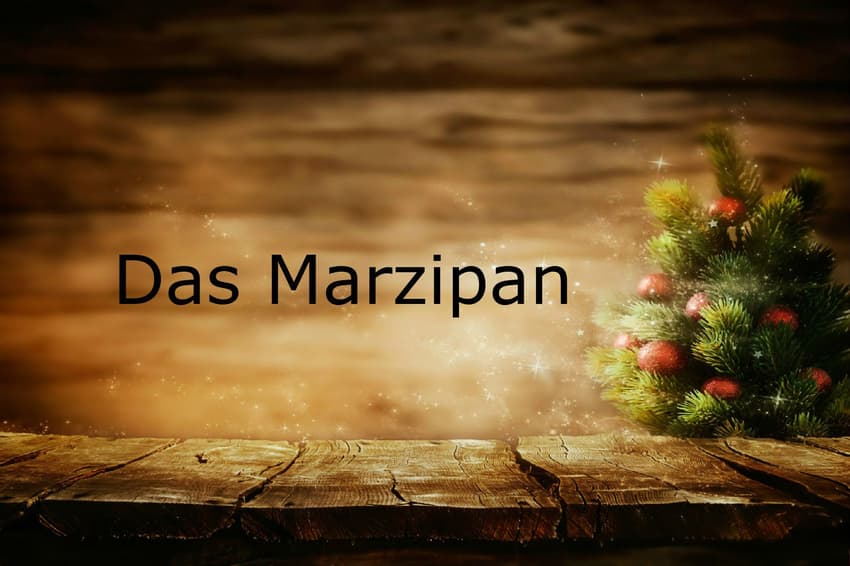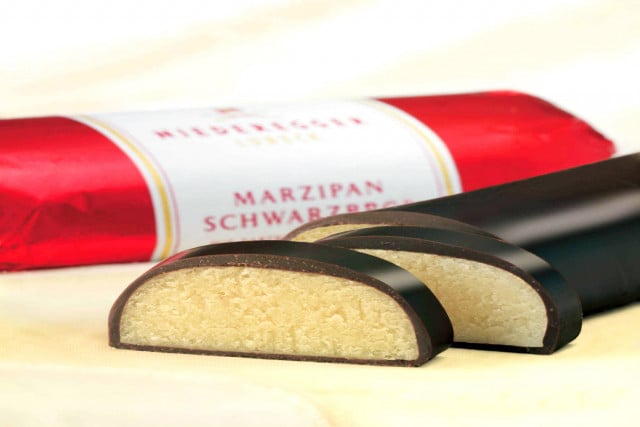German Advent word of the day: Das Marzipan

Soft, gooey, with nuts, covered in chocolate, you name it. This German treat is a must during Christmas.
Germany is renown for its marzipan, and it is enjoyed all throughout the year, especially during Christmas time.
What does it refer to?

A bar of Niederegger Marzipan covered in dark chocolate, Photo: DPA
“Marzipan” is a soft almond paste, made from blanched, milled almonds, and manufactured with powdered sugar and rose water.
Usually, it is processed into sweets such as pralines, or used for baking and decorating cakes for example.
What is the history behind marzipan?
Marzipan has a long history.
It probably originated in the Orient. It is assumed that it first appeared in the 6th and 7th century in today's Iran.
During the Crusades, it was traded by Arabic merchants across Europe, and processed especially in areas such as Spain and Italy.
In the Middle Ages, marzipan was a luxury because only upper class citizens could afford ingredients such as sugar.
But once sugarcane could be cultivated and sugar gained as the final product, marzipan was available for everyone.
Particularly, confectioners took a liking to marzipan (because it was delicious and pliable) and began baking and sculpting with it.
Nowadays, it is a common product around Europe, especially in Germany (Lübecker Marzipan) and Spain (Mazapán de Toledo).
How do you find it in Germany?
In regular grocery stores you will find “Marzipanrohmasse” (literally “marzipan raw mass”) which is the primary product which can be further processed into candies, cakes and other tasty treats.
In the baking department of the supermarket, you will also come across colored marzipan, and even marzipan rolled out perfectly into an outer layer for a cake called “Marzipandecke” (marzipan blanket/cover).
For bakers reading this, Germans use marzipan like fondant. It’s moldable, but has more flavour than simply sweet which is why you will find it everywhere.
Apart from baking, it comes in every shape, size, flavor and color imaginable (Germans go crazy for this).
But classically, marzipan is covered in dark chocolate. Many varieties have evenadded flavours such as coffee or pistachio, or are filled with a nougat center.
During Christmas, marzipan takes on another role. Of course you will find the classic kinds wrapped in Christmas decorations, but you will also definitely come across “Marzipankartoffeln” (marzipan potatoes).
“Marzipankartoffeln” are the classic Christmas sweet.
They are small balls of marzipan powdered with cocoa. Their size is perfect for popping one directly into your mouth, and tempting for eating dozens of them.
Examples
“Hast du schon die Marzipankartoffeln für den ersten Advent gekauft?”
“Have you already bought the marzipan potatoes for the first of Advent?”
“Lass uns mal die nächsten Kekse mit Marzipan machen.”
“Let’s make the next cookies with marzipan.”
Comments
See Also
Germany is renown for its marzipan, and it is enjoyed all throughout the year, especially during Christmas time.
What does it refer to?

A bar of Niederegger Marzipan covered in dark chocolate, Photo: DPA
“Marzipan” is a soft almond paste, made from blanched, milled almonds, and manufactured with powdered sugar and rose water.
Usually, it is processed into sweets such as pralines, or used for baking and decorating cakes for example.
What is the history behind marzipan?
Marzipan has a long history.
It probably originated in the Orient. It is assumed that it first appeared in the 6th and 7th century in today's Iran.
During the Crusades, it was traded by Arabic merchants across Europe, and processed especially in areas such as Spain and Italy.
In the Middle Ages, marzipan was a luxury because only upper class citizens could afford ingredients such as sugar.
But once sugarcane could be cultivated and sugar gained as the final product, marzipan was available for everyone.
Particularly, confectioners took a liking to marzipan (because it was delicious and pliable) and began baking and sculpting with it.
Nowadays, it is a common product around Europe, especially in Germany (Lübecker Marzipan) and Spain (Mazapán de Toledo).
How do you find it in Germany?
In regular grocery stores you will find “Marzipanrohmasse” (literally “marzipan raw mass”) which is the primary product which can be further processed into candies, cakes and other tasty treats.
In the baking department of the supermarket, you will also come across colored marzipan, and even marzipan rolled out perfectly into an outer layer for a cake called “Marzipandecke” (marzipan blanket/cover).
For bakers reading this, Germans use marzipan like fondant. It’s moldable, but has more flavour than simply sweet which is why you will find it everywhere.
Apart from baking, it comes in every shape, size, flavor and color imaginable (Germans go crazy for this).
But classically, marzipan is covered in dark chocolate. Many varieties have evenadded flavours such as coffee or pistachio, or are filled with a nougat center.
During Christmas, marzipan takes on another role. Of course you will find the classic kinds wrapped in Christmas decorations, but you will also definitely come across “Marzipankartoffeln” (marzipan potatoes).
“Marzipankartoffeln” are the classic Christmas sweet.
They are small balls of marzipan powdered with cocoa. Their size is perfect for popping one directly into your mouth, and tempting for eating dozens of them.
Examples
“Hast du schon die Marzipankartoffeln für den ersten Advent gekauft?”
“Have you already bought the marzipan potatoes for the first of Advent?”
“Lass uns mal die nächsten Kekse mit Marzipan machen.”
“Let’s make the next cookies with marzipan.”
Join the conversation in our comments section below. Share your own views and experience and if you have a question or suggestion for our journalists then email us at [email protected].
Please keep comments civil, constructive and on topic – and make sure to read our terms of use before getting involved.
Please log in here to leave a comment.